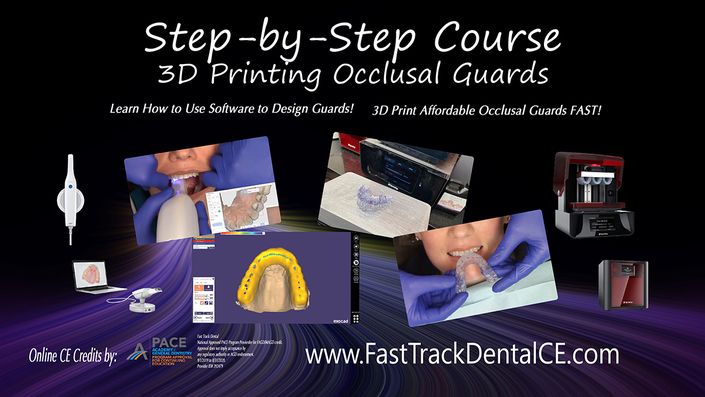
Step-by-Step 3D Printing Occlusal Guards
Learn How to Use Intraoral Scanning, Digital Design Software to Design Guards, 3D Print Occlusal Guards, and Clinical Steps for Adjusting Guards and Delivery
Are you interested in making your own occlusal guards or bite appliances using digital technology such as scanning and 3D Printing? Are you interested in making your guards fit better, faster, and easier?
This course covers the essentials of what you, your assistants, and
your laboratory needs to know about scanning, designing, and 3D printing for occlusal guards! We cover the step by step protocols using intraoral
and optical scanning techniques, software design the guards, 3D
printing techniques, finishing and polishing techniques, and the clinical procedures for delivering the guard. We teach using low-cost, desktop grade 3D printers that can produce occlusal guards for a fraction of what they cost from the lab!
Included is up to 3CEU of AGD PACE continuing education credit.
This course utilizes learning skills and educational content that is 20% projection slides and 80% video-based education. We emphasize simulated "LIVE" video based techniques to demonstrate the use of scanners, printers, software, and surgical guide fabrication and demonstration.
Chapter 1: Introduction to Digital Occlusal Guards
Topics include:
- Overview of How to Produce Intraoral Scans and Designing Guards
- Clinical Step-by-Step Protocol Checklist
- Multiple Methods for Scanning and Designing
Chapter 2: Material Options for 3D Printed Occlusal Guards
Topics include:
- Nextdent Clear
- Nextdent Orthorigid
- Keyprint Soft Resin
- Sprintray Splint
- Comparing Milled vs. Printed Guards
Chapter 3: Scanning Using the Medit i500 Intraoral Scanner
Topics include:
- Setting Up New Scan Orders
- Scanning Strategy
- Scanning Bites
- Exporting Files to the Lab/USB/Network Drive
Chapter 4: Scanning Using the 3Shape TRIOS Intraoral Scanner
Topics include:
- Setting Up New Scan Orders
- Scanning Strategy
- Scanning Bites
- Exporting Files to the Lab/USB/Network Drive
Chapter 5: Designing the Occlusal Guard Using exocad
Topics include:
- Basics of Using exocad software
- Importing Scan Files
- Blocking Out Models
- Design Parameters for Guards
- Exporting Designed Guards from exocad to 3D Printing Software
Chapter 6: Designing Models using exocad Model Creator
Topics include:
- Cutting Away Excessive Scan Areas
- Building Models & Procedures
- How to Hollow-Out Models to Save Resin
- Adding Articulator Pins
- Exporting Designed Models from exocad to 3D Printing Software
Chapter 7: 3D Printing KeySplint Soft Occlusal Guard
Topics include:
- Importing Design STL Files into Rayware Software; Adding Supports
- Setting up Sprintray Pro Printer for Printing Guards
- Removing the Printed Guard From the Printer Platform
- Washing & Cleaning the Printed Guard
- UV Curing Techniques
Chapter 8: 3D Printing Models for Fitting the Guard & Checking the Bite
Topics include:
- Importing Model STL Files into Rayware Software; Adding Supports
- Setting up Sprintray Pro Printer for Printing Models
- Removing the Printed Models From the Printer Platform
- Washing & Cleaning the Printed Models
- UV Curing Techniques
Chapter 9: Laboratory Step-by-Step Adjustment and Polishing of the Printed Occlusal Guard
Topics include:
- Removing Supports and Polishing the Occlusal Guard
- Fitting the Guard to Models to Confirm Passive Fit
- Properly Adjusting Occlusion in the Laboratory
- Polishing the Printed Occlusal Guard
Chapter 10: Clinical Step-by-Step Delivering the Occlusal Guard
Topics include:
- Clinical Step-by-Step Protocol Checklist
- Setting Up the Clinical Tretament Room For Fitting Occlusal Guards
- Working with Keysplint Soft Guards and Initial Fitting Technique
- Clinical Procedures to Properly Adjusting Fit and Occlusion in the Chair
Continuing Education Credits provided by:

Fast Track Dental
Nationally Approved PACE Program Provider for FAGD/MAGD credit.
Approval does not imply acceptance by
any regulatory authority or AGD endorsement.
9/1/2025 to 8/31/2028.
Provider ID# 392479
Your Instructor

Dr. Michael Scherer is an Assistant Clinical Professor at Loma Linda University, a Clinical Instructor at University of Nevada – Las Vegas, and maintains a practice limited to prosthodontics and implant dentistry in Sonora, California. He is a fellow of the American College of Prosthodontists, has published articles, books, and in-person and online courses related to implant dentistry, clinical prosthodontics, and digital technology with a special emphasis on full-arch reconstruction. As an avid technology & computer hobbyist, Dr. Scherer’s involvement in digital implant dentistry has led him to develop and pioneer new approaches with 3D printing, CAD/CAM surgical systems, implement interactive CBCT implant planning, and outside of the box radiographic imaging and digital design concepts.
Course Curriculum
-
StartChapter 1: Introduction to Digital Occlusal Guards (6:49)
-
StartChapter 2: Material Options for 3D Printed Occlusal Guards (14:24)
-
StartChapter 3: Scanning using the Medit i500 Intraoral Scanner (15:07)
-
StartChapter 4: Scanning using the 3Shape TRIOS Intraoral Scanner (12:38)
-
StartChapter 5: Designing the Occlusal Guard using exocad (28:31)
-
StartChapter 6: Designing Models using exocad Model Creator (22:45)
-
StartChapter 7: 3D Printing KeySplint Soft Occlusal Guard (14:50)
-
StartChapter 8: 3D Printing Models for Fitting the Guard & Checking the Bite (17:26)
-
StartChapter 9: Laboratory Step-by-Step Adjustment and Polishing of the Printed Occlusal Guard (10:16)
-
StartChapter 10: Clinical Step-by-Step Delivering the Occlusal Guard (10:28)
-
StartCE Self Assessment
